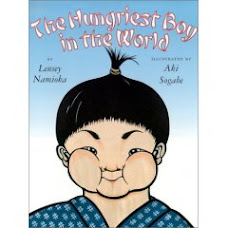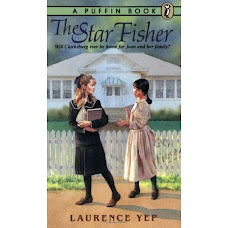BIBLIOGRAPHY
Erdrich, Louise. 2002. THE RANGE ETERNAL. illustrated by Steve Johnson and Lou Fancher. Hyperion: New York ISBN-10: 0786802200 ISBN-13: 978-0786802203
SUMMARY
An Ojbwa family lives in a cabin with mica windows in the Turtle Mountains in South Dakota. Mother cooks soup on the Range Eternal. It is an old wood cook stove that is that heats the home as part of it's duties. She learned to write her letters from the words on the front of the Eternal Range stove. With charcoal from the stove she learned to write on the margins of her father's newspaper. She slept in a cot near the stove with a warm stone from the fire wrapped in a cloth at her feet.
Electricity came to the cabin while she was a child. The years have brought electric lights instead of kerosene lamps. The Range Eternal was taken and hauled away. It was replaced with a new electric stove. In the summer the Range Eternal wasn't missed as it would heat the house when bread was baked. In the winter the hot flames and warm potatoes in your pockets were missed. The visions in the flames were missed the most.
Grown, with a family of her own. She still misses the memories of the Range Eternal. She finds a blue Eternal Range wood stove in a store window and makes it a part of her home. The flames bring back the memories of childhood when she envisioned the animals running on the plain. She shares her vision of shadows and flames with her family in their city home.
CRITICAL ANALYSIS
The illustrations draw you in to the story and life on the South Dakota plains. The warm colors are reflected in the visions in the flames. The cool colors make the cold a reality. You can almost feel the warm potatoes in your pockets. The characters are welcoming and loving in their representation. A close family and sense of caring is reflected in the illustrations.
The cultural markers used in the story are tied to stories of the past. Windigo the ice monster with wind claws and ice teeth is an Ojbwa story that frightens children. Without the warmth of the Range Eternal, Winingo can get closer. The child sees visions in the flames they are memories of old Ojbwa tales that she has heard growing up. The play on words tie the old stories of the animals that are plentiful on the range to the vision seen in the Range Eternal in the flames. The young girl in the story is the author telling of her memory of a simple life growing up in South Dakota. She is a member of the Turtle Mountain Band of Ojbwa. As a child she is comforted by the dancing flames in the old cook stove. The clothing is generic and fits to the time of the story. Electricity coming to the cabin may show the isolation living in a remote area of the country. The story is recommended for 4 - 8 years but will also be enjoyed by adults that understand the pull of childhood memories.
REVIEWS
Publishers Weekly
Erdrich (The Birchbark House) skillfully weaves family memories into a poignant and lyrical story of home and hearth. The symbolism may be more moving to adults, but the theme of family and preservation will resonate with children. A young mother relates how when she was a girl in the Turtle Mountains, a wood-burning, enameled stove ("The Range Eternal" emblazoned on the front) provided the family with good soup, warmth and protection. As she looks through the stove's window, the girl sees in its flames "pictures of long ago" that conjure up a range of another kind ("I saw the range of the buffalo... the wolf range and fox range.... I saw the Range Eternal." Johnson and Francher (New York's Bravest) suffuse their breathtaking paintings with light-buffalo and deer gallop in golden clouds across the landscape; in a later painting, the steam from a pot of soup curls through the afternoon sun as the young mother longs for a "center of true warmth" like that of her childhood. When she finds a stove just like her family's in an antique shop, she brings it home and teaches her son "to enter the pictures... to see... the living range restored." Erdrich skillfully works in homely details, crafting language both musical and evocative (the girl is "tucked into the stillness" on a winter night; the stove is the "warm heart of the house"). Sumptuous paintings of the plains and cozy domestic scenes combine with graceful language to describe the rituals that keep family and community together. Ages 4-7.Copyright 2002 Reed Business Information, Inc.
From School Library Journal
Kindergarten-Grade 4-In this evocative glimpse into the past, a narrator recalls the blue enamel stove of her childhood home in the mountains of North Dakota. Her mother cooks with one hand while feeding the fire with the other. A girl thaws herself by the stove after chores. Stones warmed in the stove keep feet cozy on winter nights; hot potatoes keep hands from freezing on winter walks to school. The stove offers more than heat. It provides light and comfort against night fears and casts shadows on the wall that turn into pictures of the plains long ago, thick with grazing buffalo. The raised lettering on the stove, The Range Eternal, provides an early writing lesson. Much is lost the year electricity comes down the road, and the enamel range is traded for an electric one. Years later, the nostalgic young woman finds The Range Eternal in an antique store and is able to bring her memories to life for her son and her husband. Dreamy illustrations in muted colors float across the pages with the texture of steam, wind, and shadows forming connections between past and present. This is a peaceful story of imagination, memories, and the ties among generations.Susan Oliver, Tampa-Hillsborough Public Library System, FLCopyright 2002 Reed Business Information, Inc.
CONNECTIONS
*Crazy Horse's Vision. 2000. by Joseph Bruchac. S. D. Nelson Illustrator, Curtis Zunigha. Lee and Low Books Inc; New York. ISBN-10: 1591124514 ISBN-13: 978-1591124511
Draw pictures or write stories about things that make you feel warm and comfortable.
Sunday, July 15, 2007
Subscribe to:
Post Comments (Atom)







No comments:
Post a Comment